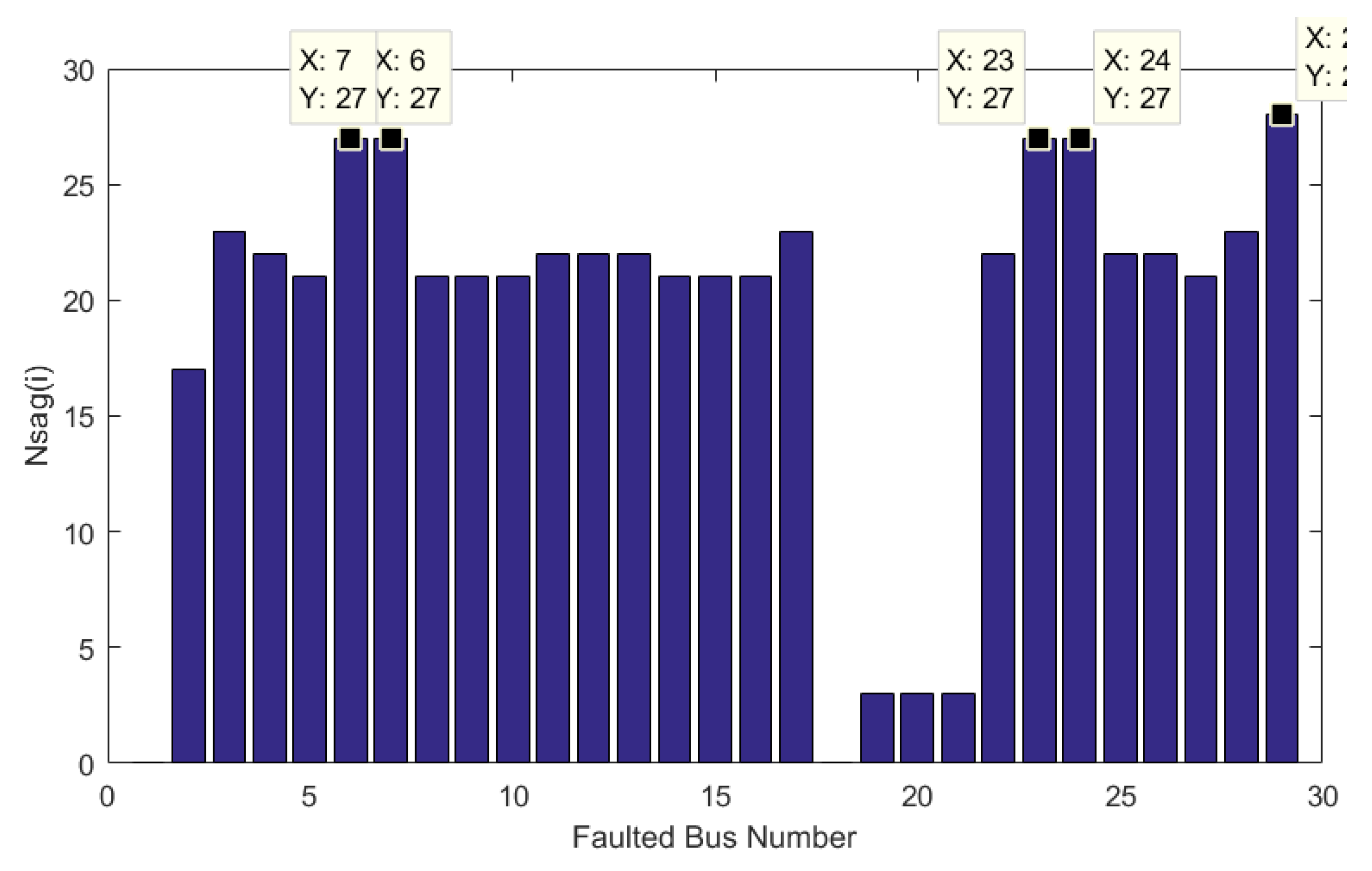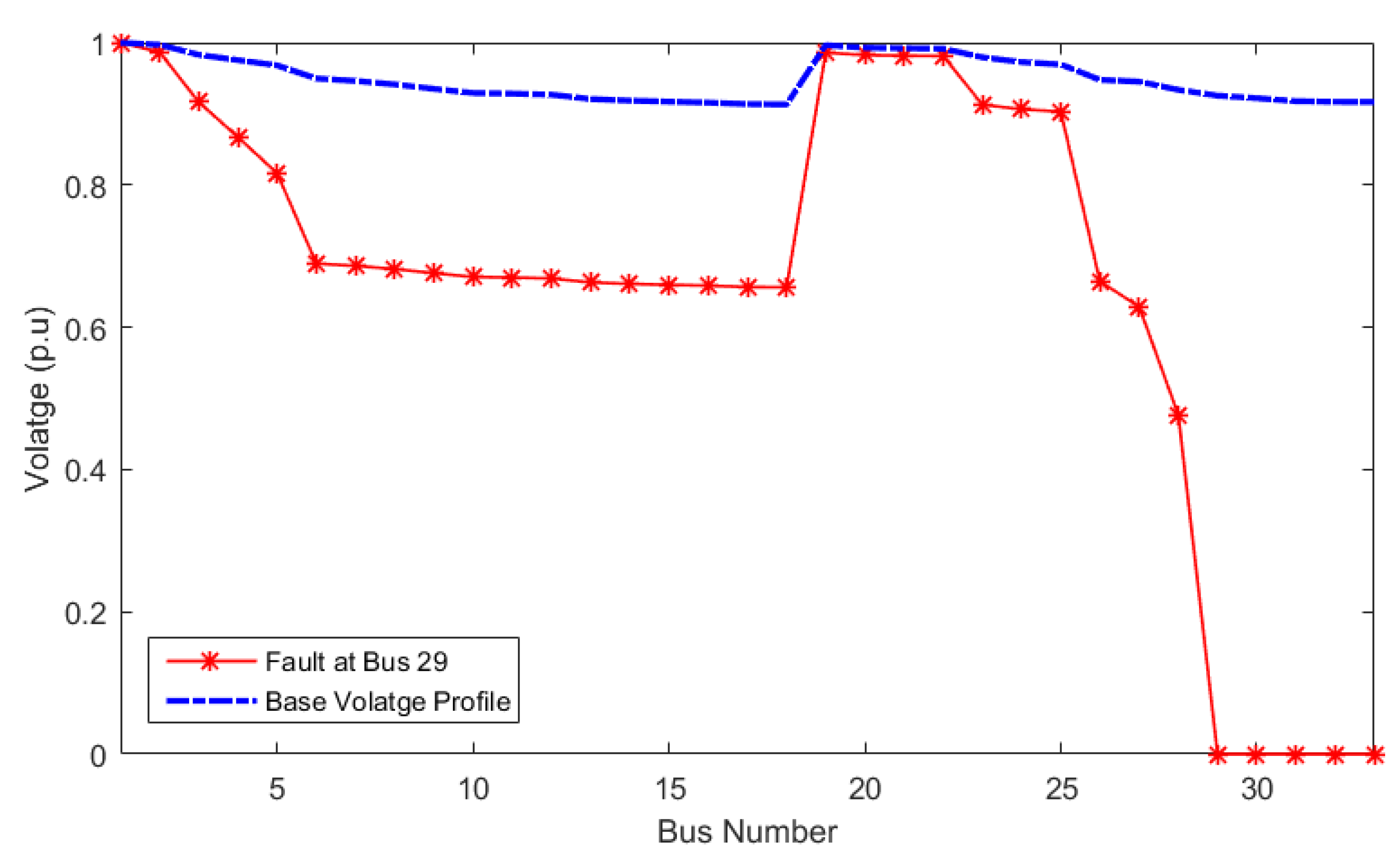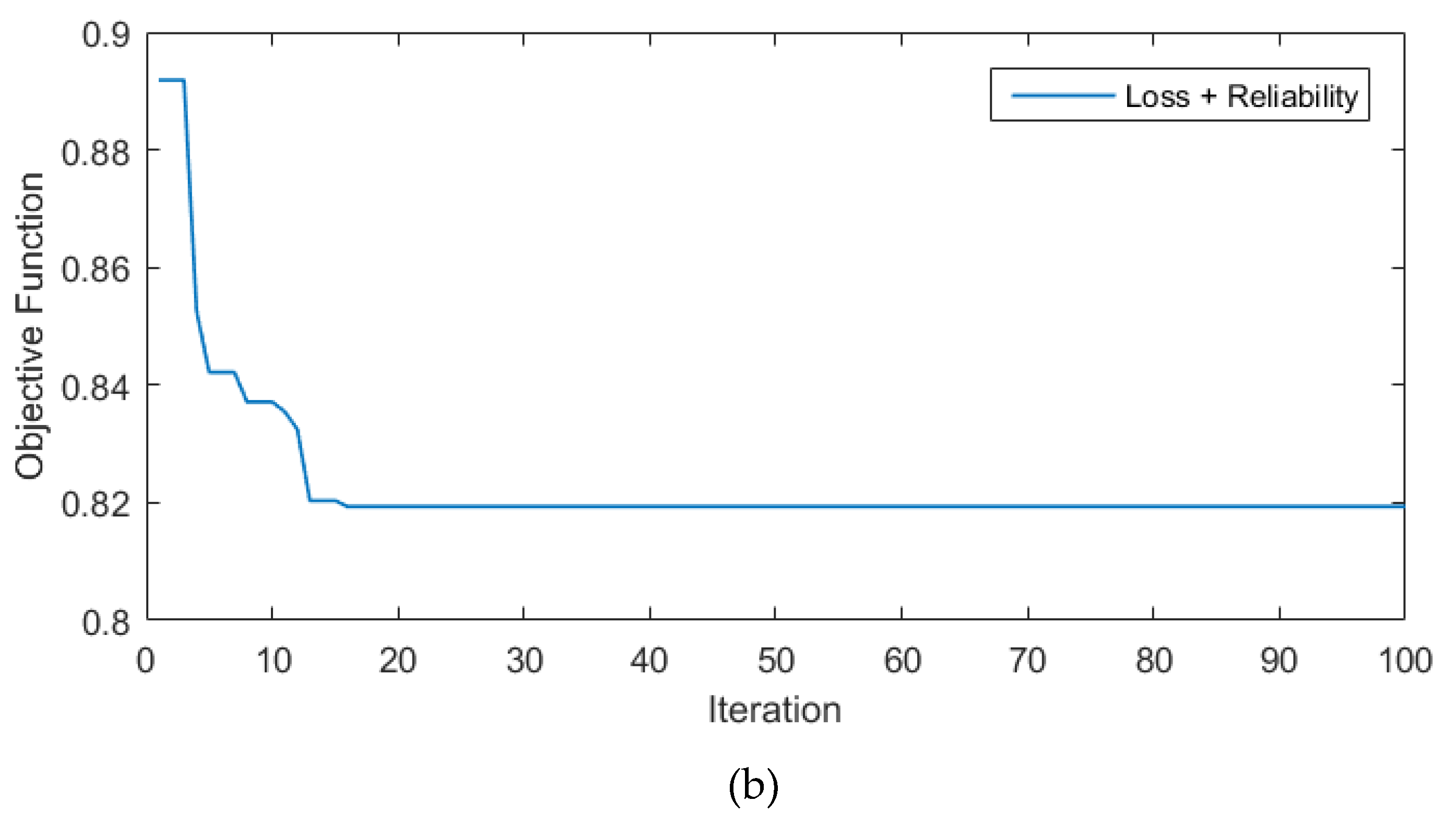Submitted:
26 July 2023
Posted:
28 July 2023
You are already at the latest version
Abstract
Keywords:
1. Introduction
1.1. Motivation
1.2. Literature review and research gap
1.3. Contributions
1.3. Paper structure
2. Problem Statement
2.1. Objective function
2.2. Constraints
2.2.1. Power flow
2.2.2. Voltage
2.2.3. Current
2.2.4. Radiality condition
3. Proposed Optimizer
3.1. Overview of the MTBO
3.1.1. Inspiration
3.1.2. First phase: coordinated mountaineering
3.1.3. Second phase: natural catastrophes' impact
3.1.4. Third phase: concerted action by many people to prevent catastrophes
3.1.5. Fourth phase: potential members' demise
3.2. Overview of the improved MTBO (IMTBO)
3.3. Implementation of the IMTBO
4. Uncertainty Modeling based on the UT
5. Results and Discussions
5.1. Results of the base network (Case 1)
5.2. Results of dual-objective reconfiguration (Cases 2 and 3)
5.3. Results of MOIF for reconfiguration (Case 4)
5.4. Analysis of different cases

5.5. Comparison with previous studies
5.6. Results of MOIF for reconfiguration considering demand uncertainty (Case 5)

5. Conclusions
Author Contributions
Funding
Data Availability Statement
Conflicts of Interest
References
- Mohammadi, M., & Akbari Nasab, M. (2011). Voltage sag mitigation with D-STATCOM in distribution systems. Australian Journal of Basic and Applied Sciences, 5(5), 201-207.
- Transmission and Distribution Committee. (2003). IEEE Guide for Electric Power Distribution Reliability Indices. IEEE Std 1366™-2003.
- Wang, B., Zhu, H., Xu, H., Bao, Y., & Di, H. (2021). Distribution network reconfiguration based on noisynet deep q-learning network. IEEE Access, 9, 90358-90365. [CrossRef]
- Chattopadhyay, S., Mitra, M., & Sengupta, S. (2011). Electric power quality. In Electric Power Quality (pp. 5-12). Springer Netherlands.
- Tomoiagă, B., Chindriş, M., Sumper, A., Sudria-Andreu, A., & Villafafila-Robles, R. (2013). Pareto optimal reconfiguration of power distribution systems using a genetic algorithm based on NSGA-II. Energies, 6(3), 1439-1455. [CrossRef]
- García, J. A. M., & Mena, A. J. G. (2013). Optimal distributed generation location and size using a modified teaching–learning based optimization algorithm. International journal of electrical power & energy systems, 50, 65-75. [CrossRef]
- Rao, R. V., Savsani, V. J., & Vakharia, D. P. (2012). Teaching–learning-based optimization: an optimization method for continuous non-linear large scale problems. Information Sciences, 183(1), 1-15. [CrossRef]
- Chen, S. L., Chen, G. B., Hsu, S. C., Chen, A. Y. T., Guo, T. Y., Huang, F. F., & Huang, Y. C. (2002, October). Mitigation of voltage sags by network reconfiguration of a utility power system. In Transmission and Distribution Conference and Exhibition 2002: Asia Pacific. IEEE/PES (Vol. 3, pp. 2067-2072). IEEE. [CrossRef]
- Yun, S. Y., Oh, J. H., Rim, S. J., & Kim, J. C. (2000). Mitigation of voltage sag using feeder transfer in power distribution system. In Power Engineering Society Summer Meeting, 2000. IEEE (Vol. 3, pp. 1421-1426). IEEE. [CrossRef]
- Torres, J., Guardado, J. L., Rivas-Dávalos, F., Maximov, S., & Melgoza, E. (2013). A genetic algorithm based on the edge window decoder technique to optimize power distribution systems reconfiguration. International Journal of Electrical Power & Energy Systems, 45(1), 28-34. [CrossRef]
- Jazebi, S., Hosseinian, S. H., & Vahidi, B. (2011). DSTATCOM allocation in distribution networks considering reconfiguration using differential evolution algorithm. Energy Conversion and Management, 52(7), 2777-2783. [CrossRef]
- Salman, N., Mohammed, A., & Shareef, H. (2009, November). Reinforcement of power distribution network against voltage sags using graph theory. In Research and Development (SCOReD), 2009 IEEE Student Conference on (pp. 341-344). IEEE. [CrossRef]
- Jakus, D., Čađenović, R., Vasilj, J., & Sarajčev, P. (2020). Optimal reconfiguration of distribution networks using hybrid heuristic-genetic algorithm. Energies, 13(7), 1544. [CrossRef]
- Swaminathan, D., Rajagopalan, A., Montoya, O. D., Arul, S., & Grisales-Noreña, L. F. (2023). Distribution Network Reconfiguration Based on Hybrid Golden Flower Algorithm for Smart Cities Evolution. Energies, 16(5), 2454. [CrossRef]
- Pereira, E. C., Barbosa, C. H., & Vasconcelos, J. A. (2023). Distribution Network Reconfiguration Using Iterative Branch Exchange and Clustering Technique. Energies, 16(5), 2395. [CrossRef]
- Kahouli, O., Alsaif, H., Bouteraa, Y., Ben Ali, N., & Chaabene, M. (2021). Power system reconfiguration in distribution network for improving reliability using genetic algorithm and particle swarm optimization. Applied Sciences, 11(7), 3092. [CrossRef]
- Quintana, E., & Inga, E. (2022). Optimal reconfiguration of electrical distribution system using heuristic methods with geopositioning constraints. Energies, 15(15), 5317. [CrossRef]
- Yang, M., Li, J., Li, J., Yuan, X., & Xu, J. (2021). Reconfiguration strategy for dc distribution network fault recovery based on hybrid particle swarm optimization. Energies, 14(21), 7145. [CrossRef]
- Ayalew, M., Khan, B., & Alaas, Z. M. (2022). Optimal Service Restoration Scheme for Radial Distribution Network Using Teaching Learning Based Optimization. Energies, 15(7), 2505. [CrossRef]
- Shareef, H., Ibrahim, A. A., Salman, N., Mohamed, A., & Ai, W. L. (2014). Power quality and reliability enhancement in distribution systems via optimum network reconfiguration by using quantum firefly algorithm. International Journal of Electrical Power & Energy Systems, 58, 160-169. [CrossRef]
- Čađenović, R., Jakus, D., Sarajčev, P., & Vasilj, J. (2018). Optimal distribution network reconfiguration through integration of cycle-break and genetic algorithms. Energies, 11(5), 1278. [CrossRef]
- Shaheen, A. M., Elsayed, A. M., El-Sehiemy, R. A., & Abdelaziz, A. Y. (2021). Equilibrium optimization algorithm for network reconfiguration and distributed generation allocation in power systems. Applied Soft Computing, 98, 106867. [CrossRef]
- Ali, Z. M., Diaaeldin, I. M., El-Rafei, A., Hasanien, H. M., Aleem, S. H. A., & Abdelaziz, A. Y. (2021). A novel distributed generation planning algorithm via graphically-based network reconfiguration and soft open points placement using Archimedes optimization algorithm. Ain Shams Engineering Journal, 12(2), 1923-1941. [CrossRef]
- Fathi, R., Tousi, B., & Galvani, S. (2021). A new approach for optimal allocation of photovoltaic and wind clean energy resources in distribution networks with reconfiguration considering uncertainty based on info-gap decision theory with risk aversion strategy. Journal of Cleaner Production, 295, 125984. [CrossRef]
- Azad-Farsani, E., Sardou, I. G., & Abedini, S. (2021). Distribution Network Reconfiguration based on LMP at DG connected busses using game theory and self-adaptive FWA. Energy, 215, 119146. [CrossRef]
- Wang, X., Liu, X., Jian, S., Peng, X., & Yuan, H. (2021). A distribution network reconfiguration method based on comprehensive analysis of operation scenarios in the long-term time period. Energy Reports, 7, 369-379. [CrossRef]
- Nguyen, T. T., Nguyen, T. T., Nguyen, N. A., & Duong, T. L. (2021). A novel method based on coyote algorithm for simultaneous network reconfiguration and distribution generation placement. Ain Shams Engineering Journal, 12(1), 665-676. [CrossRef]
- Anteneh, D., Khan, B., Mahela, O. P., Alhelou, H. H., & Guerrero, J. M. (2021). Distribution network reliability enhancement and power loss reduction by optimal network reconfiguration. Computers & Electrical Engineering, 96, 107518. [CrossRef]
- Qu, Y., Liu, C. C., Xu, J., Sun, Y., Liao, S., & Ke, D. (2021). A global optimum flow pattern for feeder reconfiguration to minimize power losses of unbalanced distribution systems. International Journal of Electrical Power & Energy Systems, 131, 107071. [CrossRef]
- Abdelkader, M. A., Osman, Z. H., & Elshahed, M. A. (2021). New analytical approach for simultaneous feeder reconfiguration and DG hosting allocation in radial distribution networks. Ain Shams Engineering Journal, 12(2), 1823-1837. [CrossRef]
- Nowdeh, S. A., Naderipour, A., Davoudkhani, I. F., & Guerrero, J. M. (2023). Stochastic optimization–based economic design for a hybrid sustainable system of wind turbine, combined heat, and power generation, and electric and thermal storages considering uncertainty: A case study of Espoo, Finland. Renewable and Sustainable Energy Reviews, 183, 113440.
- Faridmehr, I., Nehdi, M. L., Davoudkhani, I. F., & Poolad, A. (2023). Mountaineering Team-Based Optimization: A Novel Human-Based Metaheuristic Algorithm. Mathematics, 11(5), 1273. [CrossRef]
- Zheng, T., & Luo, W. (2019). An enhanced lightning attachment procedure optimization with quasi-opposition-based learning and dimensional search strategies. Computational Intelligence and Neuroscience, 2019. [CrossRef]
- Yadav, A. (2019). AEFA: Artificial electric field algorithm for global optimization. Swarm and Evolutionary Computation, 48, 93-108. [CrossRef]
- Moghaddam, M. J. H., Kalam, A., Shi, J., Nowdeh, S. A., Gandoman, F. H., & Ahmadi, A. (2020). A new model for reconfiguration and distributed generation allocation in distribution network considering power quality indices and network losses. IEEE Systems Journal, 14(3), 3530-3538. [CrossRef]
- Naderipour, A., Abdullah, A., Marzbali, M. H., & Nowdeh, S. A. (2022). An improved corona-virus herd immunity optimizer algorithm for network reconfiguration based on fuzzy multi-criteria approach. Expert Systems with Applications, 187, 115914. [CrossRef]
- Ch, Y., Goswami, S. K., & Chatterjee, D. (2016). Effect of network reconfiguration on power quality of distribution system. International Journal of Electrical Power & Energy Systems, 83, 87-95. [CrossRef]
- Moghaddam, M. J. H., Kalam, A., Nowdeh, S. A., Ahmadi, A., Babanezhad, M., & Saha, S. (2019). Optimal sizing and energy management of stand-alone hybrid photovoltaic/wind system based on hydrogen storage considering LOEE and LOLE reliability indices using flower pollination algorithm. Renewable energy, 135, 1412-1434. [CrossRef]
- Mahdavi, S., Rahnamayan, S., & Deb, K. (2018). Opposition based learning: A literature review. Swarm and evolutionary computation, 39, 1-23. [CrossRef]
- Duan, D. L., Ling, X. D., Wu, X. Y., & Zhong, B. (2015). Reconfiguration of distribution network for loss reduction and reliability improvement based on an enhanced genetic algorithm. International Journal of Electrical Power & Energy Systems, 64, 88-95. [CrossRef]
- Mendoza, J. E., Lopez, M. E., Coello, C. C., & Lopez, E. A. (2009). Microgenetic multiobjective reconfiguration algorithm considering power losses and reliability indices for medium voltage distribution network. IET Generation, Transmission & Distribution, 3(9), 825-840. [CrossRef]
- Whitley, D. (1994). A genetic algorithm tutorial. Statistics and computing, 4(2), 65-85. [CrossRef]
- Boor, Z., & Hosseini, S. M. (2013). Optimal Placement of DG to Improve the Reliability of Distribution Systems Considering Time Varying Loads using Genetic Algorithm.










| Algorithm | Parameter |
|---|---|
| MTBO | -- |
| PSO [32] | C1= C2=2 & Inertia weight= Linearly decline from 0.9 to 0.1 |
| AEFA [33-34] | Initial value used in Coulomb’s constant (K0)=100 |
| Item | Base Network |
|---|---|
| Opened Switches | 33,34,35,36,37 |
| (kW) | 202.68 |
| 16104 | |
| 8.2331 | |
| 2.3508 | |
| 4.6479 | |
| 1.3614 | |
| 1 |
| Item/Method | Base Network | Loss + Power Quality$(Case 2) | Loss + Reliability$(Case 3) |
|---|---|---|---|
| Opened Switches | 33,34,35,36,37 | 7,9,14,28,32 | 7,8,9,16,28 |
| (kW) | 202.68 | 149.9782 | 153.5122 |
| 16104 | 10680 | 11016 | |
| 8.23 | 5.46 | 5.63 | |
| 2.35 | 2.33 | 2.11 | |
| 4.64 | 3.95 | 2.98 | |
| 1.36 | 1.36 | 1.33 | |
| 1 | 0.7629 | 0.81934 |
| Item/Method | Base Network | IMTBO | PSO | AEFA | MTBO |
|---|---|---|---|---|---|
| Opened Switches | 33,34,35,36,37 | 7,9,14,28,32 | 7,10,14,28,32 | 7,9,14,17,28 | 9,28,32,33,34 |
| (kW) | 202.68 | 139.97 | 166.94 | 146.28 | 144.77 |
| 16104 | 10680 | 11520 | 10848 | 10848 | |
| 8.23 | 5.46 | 5.88 | 5.54 | 5.54 | |
| 2.35 | 2.19 | 2.35 | 2.19 | 2.16 | |
| 4.64 | 2.57 | 2.99 | 2.95 | 2.81 | |
| 1.36 | 1.35 | 1.36 | 1.39 | 1.37 | |
| 1 | 0.74372 | 0.74594 | 0.76256 | 0.75876 |
Disclaimer/Publisher’s Note: The statements, opinions and data contained in all publications are solely those of the individual author(s) and contributor(s) and not of MDPI and/or the editor(s). MDPI and/or the editor(s) disclaim responsibility for any injury to people or property resulting from any ideas, methods, instructions or products referred to in the content. |
© 2023 by the authors. Licensee MDPI, Basel, Switzerland. This article is an open access article distributed under the terms and conditions of the Creative Commons Attribution (CC BY) license (http://creativecommons.org/licenses/by/4.0/).





